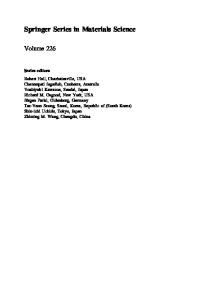Computational Materials Science of Cement-Based Materials
- PDF / 2,718,748 Bytes
- 5 Pages / 576 x 777.6 pts Page_size
- 80 Downloads / 444 Views
50
phase particles, as illustrated in the upper half of Figure 1 (also on the cover), that shows an image of real cement particles captured using a scanning electron microscope equipped with both a backscattered electron and an x-ray detector.3 This image will be used throughout this section to illustrate the operation of the microstructure model. It consists of five separate sections, each showing a different stage of the model. The first section on the left shows the initial particle shapes and phase distributions before any hydration has occurred. In this image, the five major phases of Portland cement are denoted as follows: tricalcium silicate is red, dicalcium silicate is magenta, tricalcium aluminate is green, tetracalcium aluminoferrite is orange, and gypsum (calcium sulfate dihydrate) is tan. It is only recently, by combining backscattered electron and x-ray images and by using image processing techniques, that realistic images of cement particles, in two dimensions, have been generated for use as model input.3 We have not yet been able to achieve this same result in three dimensions. The results for the computed properties of threedimensional models presented in later sections of this paper were obtained using a simpler representation of cement, in which all particles are considered to be tricalcium silicate, the major component of Portland cement; tricalcium silicate typically comprises 50-70% of the total solids on a mass basis. Long-term properties are dominated by the calcium silicate phases and their reaction products. A simplified view of how cement paste hardens is as follows. When the cement comes in contact with water, material dissolves from the particle surfaces, forming
ions in solution. These ions diffuse throughout the water-filled pore space and react with the water to form hydration products of two topological types. An amorphous calcium silicate hydrate gel (surface product) is deposited on the surfaces of the original cement particles while crystalline products, like calcium hydroxide (Ca(OH)2), nucleate and grow in the waterfilled pore space (pore products). Because water is consumed in these reactions and the lower-density hydration products occupy a larger volume than the cement from which they are formed, porosity decreases as the solid phases grow and connect together, eventually producing a rigid solid in a percolation process.4' Although the reactions are much more complicated when all of the phases shown in Figure 1 are accounted for, all hydration products can still be classified as either surface or pore products. Also, there are also generally considered to be two kinds of pores in a cement-based material: the capillary pores, comprising the left-over space between unreacted cement particles and reaction products, and gel pores, the nanometer-sized pores contained in the amorphous calcium silicate hydrate gel product. The approach taken for modeling this microstructural development is one based on digital images.6 A given volume of cement particles randomly dispersed in water
Data Loading...











